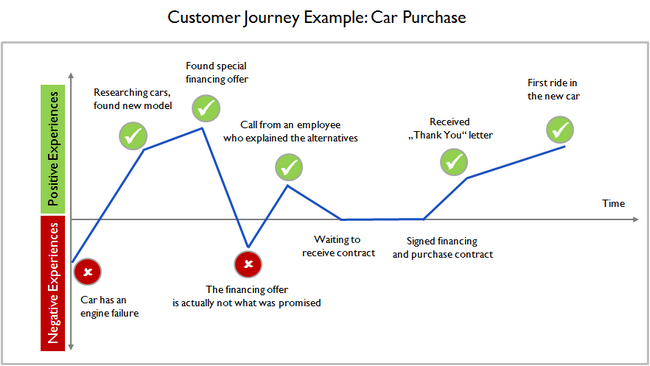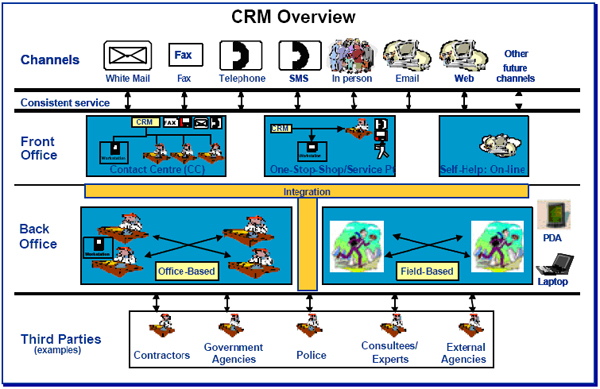CUSTOMER JOURNEY ANALYSIS
Goed gedegen artikel met een duidelijk beeld hoe een customer journey werkt.
CUSTOMER JOURNEY ANALYSIS
An Overview of Customer Journey
Customer journey is a journey of a potential customer about different points of contact with a product, a brand or a company (touchpoints) via all available channels until he performs a desired target action. A customer journey can extend over several hours or days.

- Major target actions are purchases, orders or inquiries.
- As touchpoints any kind of contact points is referred to, from classical advertising (ads, TV or radio spot, etc.) through online marketing activities through to the opinion of a friend or information on review sites.
- Available channels such as telephone, web, branch, marketing communications and service interactions.
- As consumers move across multiple channels to learn about products, services, and brands, the shape of the consumer journey changes. There are two periods of exposure that now play a much more influential role in shaping the journey than previously thought. These include the pre- and post-purchase phase where consumers are considering, evaluating, and building expectations for products, brands, and services. (source)

1. The Shape (model) of the Journey
1.1 Purchase Funnel
The ‘purchase funnel’ is a historical model which describes the theoretical customer journeyfrom the moment of first contact with your brand to the ultimate goal of a purchase. (source)
The Purchase Funnel is also often referred to as the “customer funnel,” “marketing funnel,” or “sales funnel” or “conversion funnel.”
The ‘conversion funnel‘, similar to a purchase funnel, is a phrase used in e-commerce to describe the journey a consumer takes through an Internet advertising or search system, navigating an e-commerce website and finally converting to a sale.
Many different versions have been published, but the fundamental stages remain the same. The funnel shape, number of stages and duration of the process can vary depending on both the consumer and the nature of the product, as well as many other factors.

1.2 From Traditional to Modern models
(refer to page Models for more details)
Traditional consumer journeys charted decision-making inside physical stores with an emphasis on understanding how the retail experience impacted the purchase process. This view of path-to-purchase was restricted to exploring consumer interactions with in-store touchpoints (e.g. shelving, interactions with staff, signage, etc.) as wells as the influence of brand perceptions on product consideration. This journey was depicted as a simple, linear process where brands controlled their image and reputation through carefully crafted messages targeting key consumers. Now, the influence of the Internet, social media, and mobile has changed how consumers connect with brands and locate products. This transition from in-store to online retail channels has redefined the touchpoints consumers encounter when interacting with brands and how social conversations influence brand perception.
Today’s consumer journey, instead of a linear process, is splintered with multiple touchpointsacross websites, mobile devices, traditional media channels, and retail stores.
Uncovering new stages of the consumer journey and identifying key touchpoints that shape consumer decisions is increasingly important as companies incorporate mobile and traditional channels into their sales strategy and seek new ways to influence the conversation about their brand.

2. How to map touchpoints of a Customer Journey
(refer to page Mapping for more details)
There are many ways to map a consumer journey and the design depends largely on the research objectives, the market and the industry. Below are broad steps to design a consumer journey regardless of those specifications:
STEP 1: Identify Your Consumer
Understand key characteristics of your consumer and how they interact with your brand.
STEP 2: Preliminary Research
Use existing data to identify emotions and frustrations in the consumer journey.
STEP 3: Hypothesis
Create a general framework of a consumer journey based on your preliminary research.
STEP 4: Understanding The Consumer Experience
Observe consumer interactions. Identify common emotions and needs that motivate your observed consumers to move from one step to another.
STEP 5: Mapping
Identify common touchpoints. Show general patterns of decision making. Outline these steps and what emotions, goals, or needs color them.
A customer journey map tells the story of the customer’s experience: from initial contact, through the process of engagement and into a long-term relationship.

A customer journey map takes many forms but typically appears as some type of infographic. Whatever its form, the goal is the same: to teach organizations more about their customers.

3. Customer Journey Analysis is GOOD for?
(refer to page Analysis for more details)
Having built an understanding of the customer journeys with your business you are now in a position to improve the customer experience enabling:
- Minimizing of negative customer experiences, through identification of key steps and decision points to ensure the correct information is available and accessible to all customer types.
- Improved customer retention, through understanding how they transition though each stage in their purchase lifecycle, enabling relevant and connected conversations to the customer to help them move towards a positive decision point.
- Identification of communication GAPs, where no or conflicting messages are being received. For example, use of social media to respond to customer feedback whether positive or negative.
- Understand core customer journey paths, where additional development will provide biggest impact.
- Understanding of required metrics to identify customer’s progress and fall out points, providing opportunities to bring customers back on board.
4. Applications from Customer Journey
(1) Customer Lifecycle Management (CLM)
Customer Lifecycle Management, or CLM is the measurement of multiple customer related metrics, which, when analyzed for a period of time, indicate performance of a business. The overall scope of the CLM implementation process encompasses all domains or departments of an organization, which generally brings all sources of static and dynamic data, marketing processes, and value added services to a unified decision supporting platform through iterative phases of customer acquisition, retention, cross and up-selling, and lapsed customer win-back.
Some detailed CLM models further breakdown these phases into acquisition, introduction to products, profiling of customers, growth of customer base, cultivation of loyalty among customers, and termination of customer relationship.

According to a DM Review magazine article by Claudia Imhoff, et al., “The purpose of the customer life cycle is to define and communicate the stages through which a customer progresses when considering, purchasing and using products, and the associated business processes a company uses to move the customer through the customer life cycle.”
(read more about CLM)
(2) Customer Relationship Management (CRM)
The purchase funnel can be used to guide your marketing communications strategy, and this approach is can form the start of a customer relationship marketing (CRM) programme.
Customer relationship management (CRM) is an approach to managing a company’s interaction with current and future customers. The CRM approach tries to analyze data about customers’ history with a company, in order to better improve business relationships with customers, specifically focusing on retaining customers, in order to drive sales growth.

One important aspect of the CRM approach is the systems of CRM that compile information from a range of different channels, including a company’s website, telephone, email, live chat, marketing materials, social media, and more. Through the CRM approach and the systems used to facilitate CRM, businesses learn more about their target audiences and how to best cater to their needs. However, the adoption of the CRM approach may also occasionally lead to favoritism within an audience of consumers, leading to dissatisfaction among customers and defeating the purpose of CRM.
(read more about CRM)

